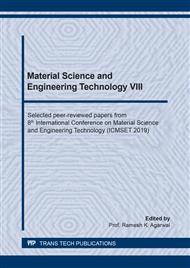[1]
Richard, P., & Cheyrezy, M. (1995). Composition of reactive powder concretes. Cement and concrete research, 25(7), 1501-1511.
DOI: 10.1016/0008-8846(95)00144-2
Google Scholar
[2]
Abbas, S., Nehdi, M. L., & Saleem, M. A. (2016). Ultra-high performance concrete: Mechanical performance, durability, sustainability and implementation challenges. International Journal of Concrete Structures and Materials, 10(3), 271.
DOI: 10.1007/s40069-016-0157-4
Google Scholar
[3]
Sun, H., Li, Z., Memon, S., Zhang, Q., Wang, Y., Liu, B., & Xing, F. (2015). Influence of ultrafine 2CaO· SiO2 powder on hydration properties of reactive powder concrete. Materials, 8(9), 6195-6207.
DOI: 10.3390/ma8095300
Google Scholar
[4]
Chan, Y. W., & Chu, S. H. (2004). Effect of silica fume on steel fiber bond characteristics in reactive powder concrete. Cement and concrete research, 34(7), 1167-1172.
DOI: 10.1016/j.cemconres.2003.12.023
Google Scholar
[5]
Bektimirova, U., Shon, C. S., Zhang, D., Sharafutdinov, E., & Kim, J. (2018). Proportioning and Characterization of Reactive Powder Concrete for an Energy Storage Pile Application. Applied Sciences, 8(12), 2507.
DOI: 10.3390/app8122507
Google Scholar
[6]
Stovall, T., De Larrard, F., & Buil, M. (1986). Linear packing density model of grain mixtures. Powder technology, 48(1), 1-12.
DOI: 10.1016/0032-5910(86)80058-4
Google Scholar
[7]
De Larrard, F., & Sedran, T. (2002). Mixture-proportioning of high-performance concrete. Cement and concrete research, 32(11), 1699-1704.
DOI: 10.1016/s0008-8846(02)00861-x
Google Scholar
[8]
Ipek, M., Yilmaz, K., Sümer, M., & Saribiyik, M. (2011). Effect of pre-setting pressure applied to mechanical behaviours of reactive powder concrete during setting phase. Construction and Building Materials, 25(1), 61-68.
DOI: 10.1016/j.conbuildmat.2010.06.056
Google Scholar
[9]
Sobolev, K., Amirjanov, A., Hermosillo, R., & Lozano, F. C. (2004). The Modeling of Dense Packing of Aggregates as an Approach to Optimizing the Proportioning of Concrete Mixtures. Internet source: http://www. mrr. dot. state. mn. us/materials/meo/2004spring/miscpapers/ d1soblev. pdf.
Google Scholar
[10]
Fennis, S. A. A. M. (2011). Design of ecological concrete by particle packing optimization.
Google Scholar
[11]
Moini, M., Sobolev, K., Flores-Vivian, I., & Amirjanov, A. (2019). Modeling and Experimental Evaluation of Aggregate Packing for Effective Application in Concrete. Journal of Materials in Civil Engineering, 31(3), 04019001.
DOI: 10.1061/(asce)mt.1943-5533.0002628
Google Scholar
[12]
Chang, C. S., & Deng, Y. (2018). A nonlinear packing model for multi-sized particle mixtures. Powder technology, 336, 449-464.
DOI: 10.1016/j.powtec.2018.06.008
Google Scholar
[13]
Ji, T., Lin, T., & Lin, X. (2006). A concrete mix proportion design algorithm based on artificial neural networks. Cement and Concrete Research, 36(7), 1399-1408.
DOI: 10.1016/j.cemconres.2006.01.009
Google Scholar
[14]
Goltermann, P., Johansen, V., & Palbøl, L. (1997). Packing of aggregates: an alternative tool to determine the optimal aggregate mix. Materials Journal, 94(5), 435-443.
DOI: 10.14359/328
Google Scholar
[15]
Ji, T., Chen, B. C., Zhuang, Y. Z., Li, F., Huang, Z. B., & Liang, Y. N. (2011). Effects of sand particle size and gradation on strength of reactive powder concrete. In Advanced Materials Research (Vol. 261, pp.208-211). Trans Tech Publications.
DOI: 10.4028/www.scientific.net/amr.261-263.208
Google Scholar
[16]
American Society for Testing and Materials. Standard Test Method for Relative Density (Specific Gravity) and Absorption of Fine Aggregate; ASTM C128; ASTM International: West Conshohocken, PA, USA, (2007).
Google Scholar
[17]
American Society for Testing and Materials. Standard Test Method for Bulk Density (Unit Weight,) and Voids in Aggregate; ASTM C29; ASTM International: West Conshohocken, PA, USA, (2007).
Google Scholar
[18]
American Society for Testing and Materials. Standard Test Method for Flow of Hydraulic Cement Mortar; ASTM C1437; ASTM International: West Conshohocken, PA, USA, (2007).
Google Scholar
[19]
American Society for Testing and Materials. Standard Test Method for Compressive Strength of Hydraulic Cement Mortars; ASTM C109; ASTM International: West Conshohocken, PA, USA, (2016).
Google Scholar
[20]
American Society for Testing and Materials. Standard Practice for Dealing with Outlying Observations; ASTM E178; ASTM International: West Conshohocken, PA, USA, (2016).
Google Scholar


